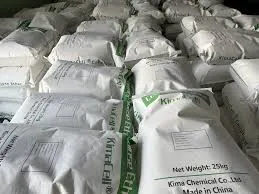
Dec . 21, 2024 15:16 Back to list
hec cellulose
HEC Cellulose A Versatile Polymer for Modern Applications
Hydroxyethyl cellulose (HEC) is a non-ionic, water-soluble cellulose ether derived from cellulose, a natural polymer obtained from plant cell walls. As one of the most widely used cellulose derivatives, HEC has gained significant attention in various industries due to its unique properties, including thickening, emulsifying, and film-forming capabilities. This article will explore the characteristics, production methods, applications, and benefits of HEC cellulose, showcasing its versatility and importance in diverse fields.
Characteristics of HEC Cellulose
HEC is distinguished by its remarkable hydrophilicity, which allows it to absorb water and swell, forming viscous solutions. This property makes HEC an excellent thickening agent, which is particularly advantageous in formulations requiring improved texture, stability, and consistency. Moreover, HEC is non-ionic, meaning it does not carry a charge, making it compatible with a variety of other compounds in formulations, including cationic and anionic substances.
The degree of substitution in HEC — which refers to the average number of hydroxyethyl groups attached to the cellulose backbone — plays a crucial role in determining its properties. Higher degrees of substitution typically enhance solubility and viscosity, making HEC suitable for use in different applications. Additionally, HEC is stable across a wide pH range (3 to 10) and exhibits thermal stability, adding to its versatility in product formulation.
Production of HEC Cellulose
The production of HEC involves the etherification of cellulose with ethylene oxide in the presence of a catalyst. This process starts with the extraction of cellulose from plant sources such as cotton or wood pulp. The cellulose is then reacted with ethylene oxide to introduce hydroxyethyl groups along the cellulose chain. After the reaction, the product is purified, washed, and dried to obtain a fine, white powder — the HEC cellulose used in various applications.
Applications of HEC Cellulose
HEC cellulose finds use in multiple industries, including
hec cellulose

1. Cosmetics and Personal Care HEC is a key ingredient in many cosmetic products, such as creams, lotions, and shampoos. Its thickening properties enhance product texture, while its film-forming ability helps create a smooth application and long-lasting finish on the skin or hair.
2. Pharmaceuticals In the pharmaceutical industry, HEC serves as a binder and thickener in tablet formulations and liquid medicines. It aids in the controlled release of active ingredients, improving the bioavailability and efficacy of the drug.
3. Food Industry As a food additive, HEC can enhance the texture of sauces, dressings, and dairy products. It acts as a stabilizer, preventing separation and improving mouthfeel, making it an essential ingredient in low-fat and reduced-calorie products.
4. Construction In construction, HEC is used in cement and gypsum-based products to improve workability and adhesion. It enhances the performance of mortars and plasters, making them easier to apply and more durable.
5. Oil and Gas HEC plays a significant role in drilling fluids due to its ability to increase viscosity and stabilize suspensions. Its use in hydraulic fracturing helps in controlling fluid loss and enhancing the efficiency of the drilling process.
Benefits of HEC Cellulose
The benefits of HEC cellulose are numerous. Its ability to dissolve in cold water, coupled with its thickening and stabilizing properties, makes it an invaluable ingredient in formulation chemistry. It is also biodegradable and derived from renewable resources, aligning with the growing trend toward sustainable and environmentally friendly products. Furthermore, HEC is recognized for its safety profile, making it suitable for use in sensitive applications such as cosmetics and food.
Conclusion
In summary, hydroxyethyl cellulose is a versatile and valuable polymer with a wide array of applications spanning cosmetics, pharmaceuticals, food, construction, and more. Its unique properties, ease of use, and eco-friendly characteristics make it a significant component in product formulation across various industries. As research and technological advancements continue to evolve, HEC cellulose is likely to be at the forefront, driving innovation and efficiency in numerous applications. Its importance cannot be overstated, as it remains a staple in the toolkit of formulators and manufacturers worldwide.
-
Versatile Hpmc Uses in Different Industries
NewsJun.19,2025
-
Redispersible Powder's Role in Enhancing Durability of Construction Products
NewsJun.19,2025
-
Hydroxyethyl Cellulose Applications Driving Green Industrial Processes
NewsJun.19,2025
-
Exploring Different Redispersible Polymer Powder
NewsJun.19,2025
-
Choosing the Right Mortar Bonding Agent
NewsJun.19,2025
-
Applications and Significance of China Hpmc in Modern Industries
NewsJun.19,2025







